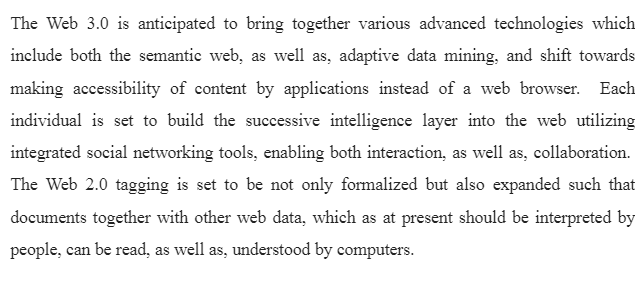Web 3.0 Contributions to E-learning-Web 3.0: The Semantic Web and Beyond
The major breakthrough contributing to the development of Web 3.0 is semantic content for Web pages and ontologies for querying. Semantic content will use semantic languages such as Resource Description Framework (RDF), Extensible Markup Language (XML), Web Ontology Language (WOL), and Extensible HTML (XHTML) to provide description for Web documents. Ontologies are statements defined in semantic languages for computers to process knowledge like humans—by deductive reasoning and inference. Therefore, Web 3.0 would provide more meaningful searches and personalized results for the user. The World Wide Web Consortium (W3C Semantic Web) heads a collaborative circle of developers, experts, and interest groups addressing Web solutions and the Semantic Web in general.
The Semantic Web will factor more than the human element into searches. It will make searches more personalized and more comprehensive. For example, in the field of law, Web 3.0 will change the way attorneys will research, produce, and present documents. Data on the Internet is essentially tagged, and it will be combined with information from various other sources to associate similarities to a case or research topic. In the medical field, Web 3.0 will improve collaboration for diagnostics and the adoption of best-of-breed practices for health care professionals all over the world. Medical content will be accessible through Internet repositories for adaptive data mining. In essence, research will be easier, all-inclusive, and better-rounded for the researcher.
Two of the goals of Web 3.0 are adaptability and the use of natural language to express complex queries. A new approach called “Responsive Web Design” (RWD) is becoming popular among website developers to enrich the navigation experience and to allow adaptive screen views for all types of mobile devices. Users will continue to build the next layer of intelligence through our individual contributions to the Web. The following sites explain the Semantic Web application to medical endeavors and e-learning.
Jessen, W. (2012). Web 3.0 and predictive, preventive, and personalized medicine. Highlight Health. Retrieved from http://www.highlighthealth.com/healthcare/web-30-and-predictive-preventive-and-personalized-medicine/
Giannakos, M., & Lapatas, G. (2010). Towards Web 3.0: Concept for collaborative e-learning. Retrieved from http://ntnu-no.academia.edu/MichailGiannakos/Papers/396841/Towards_Web_3.0_Concept_for_Collaborative_E-Learning
SLP 3 Assignment
After reviewing the course materials, submit a 2- to 3-page paper that answers the following question:
- What have been the contributions of Web 3.0 to e-learning so far?
- How can we use the latest technologies to work for educational systems?
Be creative in your answer.
SLP Assignment Expectations
Your paper should be 2–3 pages in length, and reflect your personal experiences with the timeline. The important part of all these project assignments is to carefully assess your own experiences with the topic, and then reflect critically on what you might have learned about yourself and about situations through this assessment process.
The more that you can use the exercise to develop personal implications for your growth as a potential business person as well as an Internet-savvy individual, the more value you will get out of the exercise
Answer Preview-Web 3.0 Contributions to E-learning

